
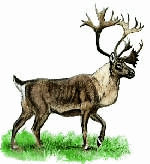
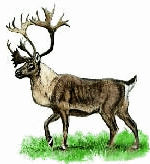
Fred and I knew almost nothing about the new life we had chosen but we were sure we wanted a dog team. A Big River man named Bill Mahoney sold us three pups for $30.00 each, and he threw in a lot of free advice. Although he had probably never been on the Churchill River (which we had chosen as our route) he and another man had hunted caribou in the winter time with two trains of dogs and a canoe around Foster Lakes - and it was Foster Lake country that we were heading for. Unfortunately for us, Bill knew only the winter portages and was not familiar with the canoe route that we could take now before the lakes were iced over. At any rate, he helped us to line up the equipment we would need for a winter in the North. We bought a toboggan, three sets of dog harness, a camp stove, a supply of traps, and a small hunting canoe. Our purchases made, we were ready to paddle the forty-five miles to the north end of Cowan Lake. Outboard motors being unknown in the North then, there was no easier way. Where the river left the lake, there was a good-sized dam. Mahoney opened up all the gates, assuring us that he would give us all the water he could. But the lake was very low that year and only a little stream trickled out from the dam. What we saw ahead was not a flowing river but a twisting bed of wet rocks. We had to portage all the rapids, one of us carrying the supplies along the shore, the other walking with the empty canoe, lifting it over the rocks. We would come hopefully around a new bend in the river - and all we could see ahead would be more rocks. Next thing, our battered canoe started to leak and we had to stop and patch it. We were three weeks on that Cowan River before we reached the Beaver, although the trip can be made easily in less than a day when the water is high! The sight of the Beaver River at last lifted our drooping spirits high. There the water was deep enough that we could run the rapids, and we travelled along at a good rate until we arrived at the little settlement of Beauval. Mahoney had told us that the country beyond looked good to him. Lac La Plonge was to the east of us, and beyond it was Tippo Lake which he told us could be reached by a trail on the east side marked "Tippo Lake Portage". We found the sign without too much trouble. There we left the freighter canoe we had been travelling in, and portaged the small one we had bought in Big River to Tippo Lake. Crossing the lake, we found a small creek flowing out of it which we understood would run into what we then called Snake Lake (now known as Pinehouse Lake). Retracing our steps, we carried our supplies to Tippo Lake, leaving the big canoe where it was. Then we paddled them across the lake and cached everything that we thought we did not immediately need. Once again we began walking, carrying the hunting canoe and three packs apiece, hoping that the creek we were following would eventually become deep enough to paddle. Now we had another problem. Our dogs were hungry and we had nothing to feed them. Plainly we had to find game very soon. I was confident that I could bring down game with the rifle I always carried, but all I could see were bear tracks - and I was wary of coming suddenly on an old she bear with cubs. I proceeded cautiously, peering into the bush. Nothing! Returning empty-handed from a foray, I suddenly saw what I thought was a big jumping deer (whitetail). In no time I had brought it down - but it was like no deer I had ever seen: It was a doe with horns! Answering my shouts, Fred hurried to the spot, and he was equally puzzled. He said this was not an elk. He had shot elk in the Duck Mountains and knew what they looked like: Only the bucks were horned.
Once we got a good start on the cabin, I went back to our cache at Tippo Lake for a pack of supplies. That trip took me two good days. Then we worked together a couple of days on the cabin, and it was Fred's turn to go for a pack. Shortly before freeze-up we had our cabin built and all our supplies under cover. It was then we realized that one necessity we had neglected to buy was a fish net. Too late we remembered that native trappers used fish for dog feed and for baiting their traps. The river by our camp wasn't big enough to support fish anyway, we realized. We had to learn the ways of the North gradually by experience and we were lucky that none of the mistakes we made that first winter were too serious. When the snow came we were ready to begin trapping. We could see from tracks and other signs that there were plenty of fox and timber wolves in the area, and some lynx. Mink, though appeared to be scarce. Next year, we told ourselves, we would locate farther north. Although we had no experience trapping fox, some of the natives gave us good advice and shortly after freeze-up, when I made a trip back to Beauval, I saw some of their sets. We began getting fox, though not as many as we should have, had we been more experienced. We had plenty of game to feed both ourselves and our dogs, and we were confident that this winter we could trap enough fur to pay for a good outfit for another year. So our first winter passed successfully enough. As soon as the ice was out of the lake in the spring and the weather was turning warm, we started our trip south, filled with summer plans that would improve our life in the North next winter.
To my dismay, I found the lake still full of ice. Worse, someone had been using our canoe and had left it partly filled with water - which of course had frozen and burst it open. That was a real blow because I had nothing to use for repairs. Still, I figured there had to be some way out of the difficulty. Prowling around, I came upon two cabins nearby that had apparently been lived in during the winter. Inside I found some tacks that had been used to fasten paper on the wall, a piece of canvas and a paint can with dried paint still in it. With these makeshift materials I was able to patch the canoe well enough to get me to Beauval, I thought. But it was a long trip that we faced, my dogs and I, and we were desperately hungry by this time. After more exploring I found a net that had apparently been left frozen into the lake. I salvaged it from the melting ice and set it in the creek. Soon there were plenty of fish for me and my dogs. Then we set out - but it was far from an easy trip. I had to do a lot of portaging and even on lakes had to pull the canoe over ice much of the time. There were not many open stretches of water so early in the spring. It was nearly a week before I finally got to Beauval. At that, I was ahead of Fred who didn't arrive until the next day. Together again, we left the small canoe at Beauval and paddled on in the freighter. In the rapids on Beaver River we began to have trouble. We tried at first to use poles as we had seen the natives doing, but we didn't yet know how to handle them and soon gave up. Wading wasn't too bad. Then we tried pulling the canoe with a line to shore, one of us staying in the canoe to keep it off the rocks. In this way, trying first one thing, then another, we finally got to Big River. From there it was easy travelling to Prince Albert where we wanted to get rifle shells, clothes and a few other supplies for next winter. That was our first return to Prince Albert, but every spring it was the same: There we would meet many trappers, fishermen and traders from the North. Our hotel manager was well prepared for our coming and he always kept plenty of rooms available for us. It was a great time for reunions and story telling. I always enjoyed talking with these men about their experiences, and I still do, though there are not many of them left anymore. In those days, some of the men, as soon as they reached Prince Albert, would blow in their whole winter's stake without a second thought. The trappers knew that the Hudson's Bay Company would give them anything they needed to start up again in the fall, and the fishermen similarly counted on credit from the fish companies. Others of these men would save as much as half of what they had made - and this was often quite a lot. I knew one man who had saved ten thousand dollars. But this was unusual, and he paid for overworking himself by having to quit the life early. My partner and I discovered that these white trappers, when they got together, didn't talk very much about trapping - at least not when we were still learning the rules of northern survival. They had all come into the North without experience and had to learn the hard way to survive and prosper - and they wanted everybody else to do the same. They would never tell newcomers or strangers about their way of life: how they lived in the North, how they caught their fur, and even what fur they caught and where. It was different, though, if they were with men who had been on the trapline for many years and didn't need advice. With such people they would exchange endless yarns. Very few of these men were married. Over the years many of them have been found dead in their lonely cabins. Few indeed are still alive. It wasn't long, that second year, until we were back in Big River hurrying to get our outfit together. There we met a man called Tom Beads who had no canoe of his own and wanted to go North with us. Tom was a native, born and raised in the South where he had put in half his life on the trapline. He was sixty years old at the time we met him, but he told us he knew the Russell Lake country where we wanted to go, and he could get an outfit from the Hudson's Bay Company once he was in the North. We decided to take him along. 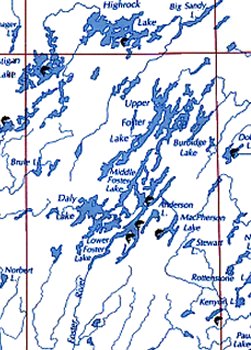
We set out the next day. This was the summer of 1925, still before outboard motors were used there, and so we had to paddle all the way, but our route was down stream until we left the Churchill River. Added to this advantage, Tom knew all the rapids on the Beaver and the Churchill as far as Stanley, and he had trapped in the Foster and High Rock Lake Country. He was a good guide and his knowledge of the area saved us a lot of time. We began making winter plans. Since it appeared that we didn't have enough equipment for three, we decided that Fred and Tom would go to Russell Lake, taking the freighter canoe and the dogs we used the winter before; I would stay at the little cabin on Brush River where we had spent the previous winter. Then I would be able, with the proceeds of this trapping season, to get a good outfit together and go further North next summer. Accordingly Fred and Tom went off together and I was left alone at the old site. There was no lack of things to fill my time. I was breaking in three pups that I had raised, and at the same time trapping the old lines. I was pleased to find that there was still plenty of fox in the country. A man has to learn how to trap each kind of animal, for different methods work with different creatures. He learns from experience and from the animals themselves. Even more important than knowing how to trap, though, is knowing how to travel, because in that country with it's huge waste spaces and its big lakes where no trapping can be done, a man must have very long traplines and that means he must travel long distances in winter. I found that long stretches of frozen river did not yield much fur - though when fox, lynx and marten are plentiful, a few can be caught on these rivers. I trapped alone until Christmas. Then Fred and Tom Beads came back because Tom wanted to return to Big River. They brought a Frenchman with them who wanted to go south, and I took him to Beauval. by dog team. I had already made several trips there for freight that had been hauled in by horse teams which then freighted fish south. That was the last time I ever saw Tom Beads.
We reached the Foster Lakes in three days. It would take the native freighters only two days to make the return trip since they now had much lighter loads and no fresh snow had fallen to give them trouble. Fred and I stayed over night at the Hudson's Bay Company outpost on the Foster Lakes. The next morning we set out for Russell Lake. Finding it impossible to follow the trail over the lakes, we kept to the portages, one of us going ahead on snowshoes, the other following with the dogs and toboggan. Fred travelled this route coming out but had made the trip only that once and couldn't remember the portages on such a long trail, so we had to spend some time looking around for the best passage. We made forty-five miles that first day before we pitched camp. The next day we were on portages more familiar to Fred. Moreover, since the lakes were small now it was easier to find the portages. There were nine of them before we came to HighRock Lake, which is really three lakes connected by narrows. Here we began to run into herds of caribou on the move. Food would be plentiful. We found our way across Highrock Lake and the worst of our journey was over. From there on the lakes were all small. All we had to do was find the creek that ran into Russell Lake and we did that. Finally we reached our camp. On this trip we learned all we needed to know about camping outside and about winter travel. We had picked up a lot from our native companions, and experience taught us the rest. We found the Russell Lake country good for mink and otter, but not quite as good as around Brush River for marten and fox. I followed that route for seven years and I got to know the country well. Once I spent the summer in Lac La Ronge and a native travelled north with me the next winter. We were both young and strong. He was an experienced canoe man and trapper. He had travelled all his life in a canoe and had started to trap with an older brother when he was only twelve years old. This man stayed on Russell Lake while I went seventy miles farther north, setting traps as I went. Both of us put up fish and meat as well. He looked after the dogs at camp while I was gone, and after freeze-up I walked back to the camp on Russell Lake.
Eventually we followed a trail into Wollaston Lake and there we met trappers from Lac La Ronge that we knew. It was a real pleasure to get together with these men. They could speak the Cree language with my partner. All that winter as we trapped together, he tried to teach me Cree and I tried to teach him English. I have to admit that he learned a lot more than I did! Both of us put up fish and meat as well. He looked after the dogs at camp while I was gone, and after freeze-up I walked back to the camp on Russell Lake. All that winter - and it was a cold one - we camped in the open except for a few nights at the cabin when we were taking care of the fur. A man can get used to waking up even with six inches of fresh snow on top of him. Such things become a normal part of life, and a man doesn't mind them. When he is outside all the time from fall to spring, he really doesn't feel the cold.
Google Maps of the areas Ed Theriau and Fred Darbyshire trapped.
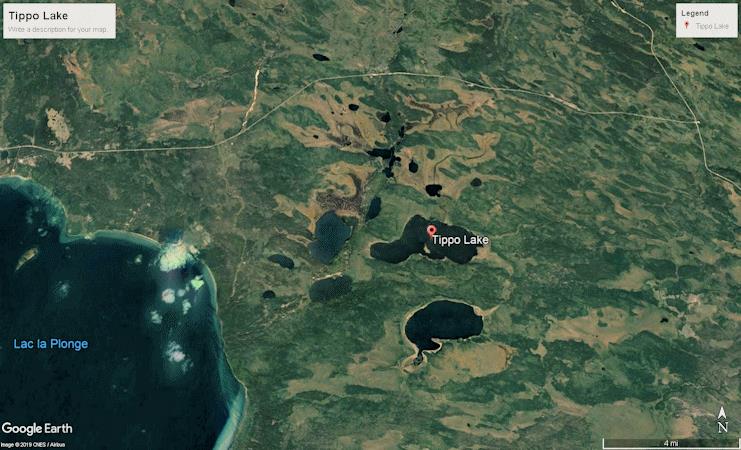
Tippo Lake.
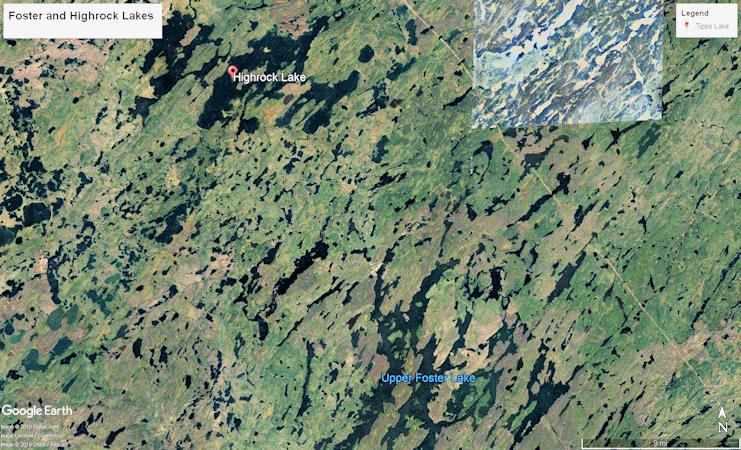
Foster and Highrock Lakes.
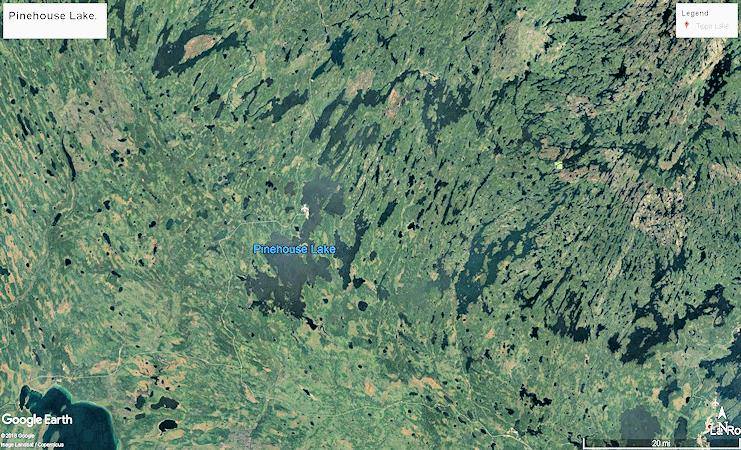
Pinehouse Lake.
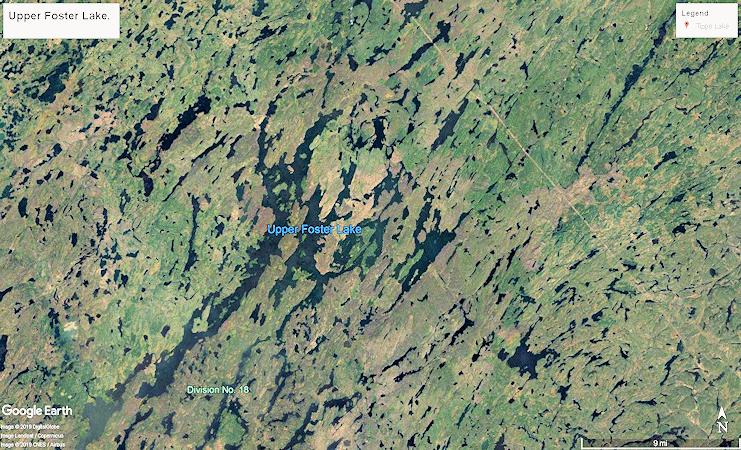
Upper Foster Lakes.
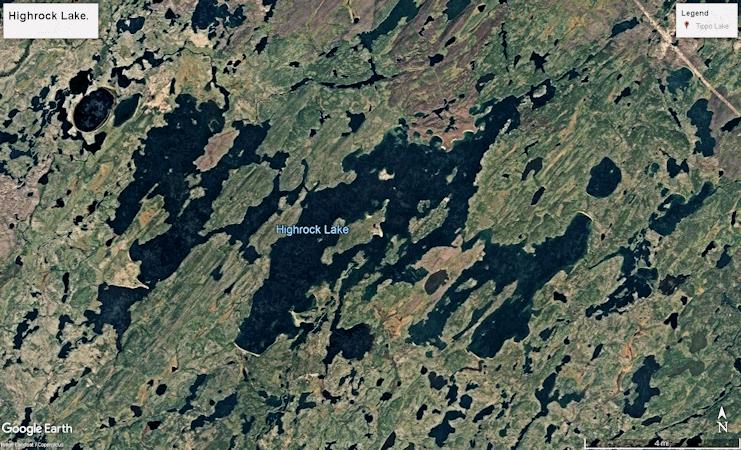
Highrock Lake.
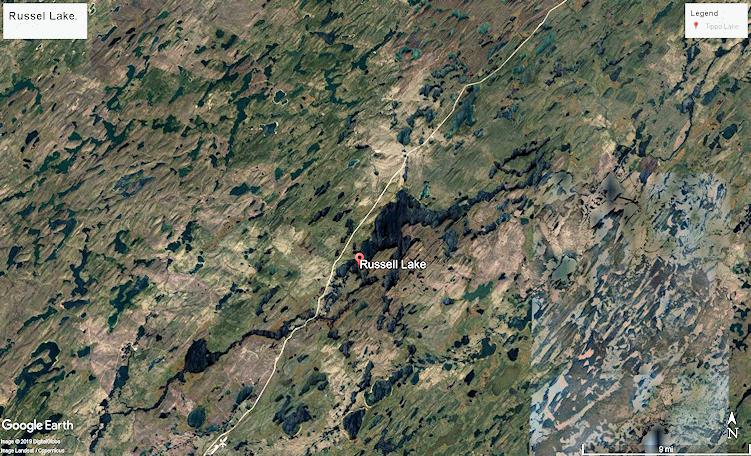
Russell Lake.
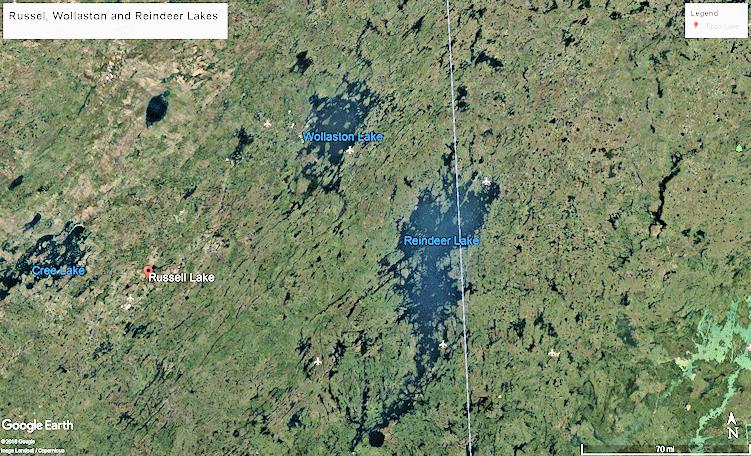
Russell, Wollaston and Reindeer Lakes.
|
| Deep River Fur Farm |
| Deep River Trapping Page |
| Deep River Fishing Page |
| My Norwegian Roots |
| Early Mink People Canada - Bowness |
| The Manager's Tale - Hugh Ross |
| Sakitawak Bi-Centennial - 200 Yrs. |
| Lost Land of the Caribou - Ed Theriau |
| The History of Buffalo Narrows |
| Hugh (Lefty) McLeod, Bush Pilot |
| George Greening, Bush Pilot |
| Timber Trails - History of Big River |
| Joe Anstett, Trapper |
| Bill Windrum, Bush Pilot |
| Face the North Wind - Art Karas |
| North to Cree Lake - Art Karas |
| Look at the Past - History Dore Lake |
| George Abbott Family History |
| These Are The Prairies |
| William A. A. Jay, Trapper |
| John Hedlund, Trapper |
| Deep River Photo Gallery |
| Cyril Mahoney, Trapper |
| Saskatchewan Pictorial History |
| Who's Who in furs - 1956 |
| Century in the Making - Big River |
| Wings Beyond Road's End |
| The Northern Trapper, 1923 |
| My Various Links Page |
| Ron Clancy, Author |
| Roman Catholic Church - 1849 |
| Frontier Characters - Ron Clancy |
| Northern Trader - Ron Clancy |
| Various Deep River Videos |
| How the Indians Used the Birch |
| Mink and Fish - Buffalo Narrows |
| Gold and Other Stories - Richards |
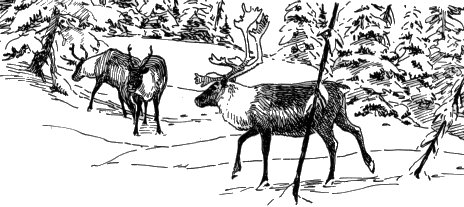 We rightly decided at last that what we had was a woodland caribou. Putting into practice what we had seen the natives do, we skinned the animal and began to dry the meat. Our worries over for a while, we put up our tent and stowed the supplies inside. Then we followed a trail and came to a spot where we thought we could launch our canoe at last. After a twenty-five mile portage, that was a welcome sight! Here we decided, was a good place to build a cabin. At that point we chose, there was good-sized river coming in from a direction opposite to that we had been portaging, and it looked inviting. We thought it surely couldn't be far now to Pinehouse Lake.
We rightly decided at last that what we had was a woodland caribou. Putting into practice what we had seen the natives do, we skinned the animal and began to dry the meat. Our worries over for a while, we put up our tent and stowed the supplies inside. Then we followed a trail and came to a spot where we thought we could launch our canoe at last. After a twenty-five mile portage, that was a welcome sight! Here we decided, was a good place to build a cabin. At that point we chose, there was good-sized river coming in from a direction opposite to that we had been portaging, and it looked inviting. We thought it surely couldn't be far now to Pinehouse Lake. Before long we parted company. Fred went down river to Pinehouse Lake and up the Churchill to meet me in Beauval. I headed for Lac La Plonge to pick up the eighteen-foot canoe we had left there.
Before long we parted company. Fred went down river to Pinehouse Lake and up the Churchill to meet me in Beauval. I headed for Lac La Plonge to pick up the eighteen-foot canoe we had left there. At Souris River, we learned that five dog trains were leaving in the morning with freight for an outpost on the Foster Lakes. Since that was the route we planned to take, we decided to go along with these men. It was the morning of January 10, 1926 that we set out. All of our toboggans were heavily loaded, not only with freight and winter supplies, but with three night's worth of dog feed as well. (We took along one fish per dog per day.) It was slow going in that rough country with our dog trains, up and down big hills. We had to help the dogs on the upward slopes, but going down hill was even worse because in order to hold the heavy sleds back we had to turn them on their sides. Still, we managed to get them down those hills without damage. That was one of the very few winters I remember when there was very little snow - and that caused us some problems. There were big frozen humps sticking out of the muskeg. Our toboggans kept upsetting when we hit them. By night the men and dogs were exhausted, but there was little chance of rest. When natives were on a trip like that, we discovered, they never wanted to pause. They started early and worked late. They were eager to get back home as fast as they could.
At Souris River, we learned that five dog trains were leaving in the morning with freight for an outpost on the Foster Lakes. Since that was the route we planned to take, we decided to go along with these men. It was the morning of January 10, 1926 that we set out. All of our toboggans were heavily loaded, not only with freight and winter supplies, but with three night's worth of dog feed as well. (We took along one fish per dog per day.) It was slow going in that rough country with our dog trains, up and down big hills. We had to help the dogs on the upward slopes, but going down hill was even worse because in order to hold the heavy sleds back we had to turn them on their sides. Still, we managed to get them down those hills without damage. That was one of the very few winters I remember when there was very little snow - and that caused us some problems. There were big frozen humps sticking out of the muskeg. Our toboggans kept upsetting when we hit them. By night the men and dogs were exhausted, but there was little chance of rest. When natives were on a trip like that, we discovered, they never wanted to pause. They started early and worked late. They were eager to get back home as fast as they could.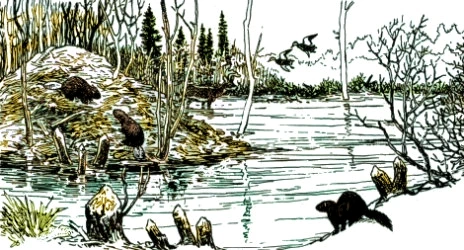 A man always makes his best catch the first trip after freeze-up. As soon as I reached camp, my partner left to see his traps. That didn't take long for he had only lake to travel on and his dogs were fresh. We stayed one day, fixed up fur, then left camp again. I knew the country north and east of there for a radius of seventy miles, but we were trapping in all new country that winter because I thought my country needed a rest. (I never believed in trapping out an area, but would every so often strike out into new territory to give the old one time to come back. A man has a responsibility not to destroy the balance of nature.) I had to pick up the traps I had left where I camped in the fall, and then we set out around Waterbury Lake - a big body of water not far from Unknown Lake. There were lots of rapids between these two lakes, excellent for mink and otter. Then we ran a trapline north to Unknown Lake. There was a lot of fur all through the North that winter. We made a trip around our traplines - then went back to Russell Lake to fix up the fur - then back to our traplines again.
A man always makes his best catch the first trip after freeze-up. As soon as I reached camp, my partner left to see his traps. That didn't take long for he had only lake to travel on and his dogs were fresh. We stayed one day, fixed up fur, then left camp again. I knew the country north and east of there for a radius of seventy miles, but we were trapping in all new country that winter because I thought my country needed a rest. (I never believed in trapping out an area, but would every so often strike out into new territory to give the old one time to come back. A man has a responsibility not to destroy the balance of nature.) I had to pick up the traps I had left where I camped in the fall, and then we set out around Waterbury Lake - a big body of water not far from Unknown Lake. There were lots of rapids between these two lakes, excellent for mink and otter. Then we ran a trapline north to Unknown Lake. There was a lot of fur all through the North that winter. We made a trip around our traplines - then went back to Russell Lake to fix up the fur - then back to our traplines again.